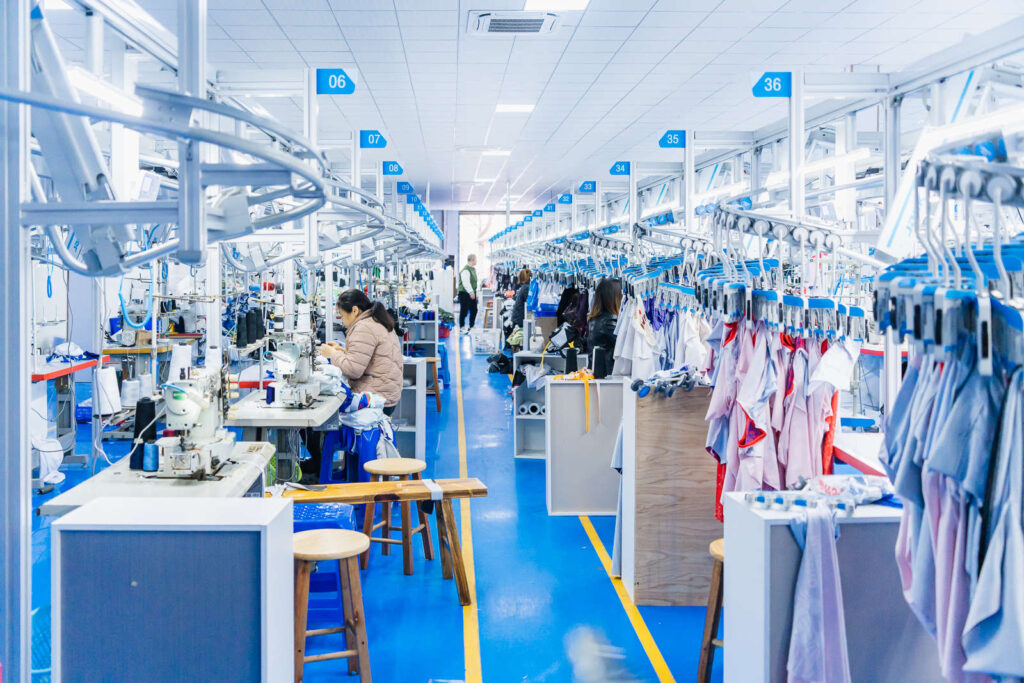Introduction
The global garment manufacturing industry is under relentless pressure to produce higher volumes, better quality, and faster turnaround while keeping costs and waste to a minimum. As brands pursue mass customization, seasonal collections, and performance fabrics, the complexity of production increases. Innovations in automation and data-driven manufacturing are therefore essential to meet these challenges.
One technology that is reshaping apparel production is the intelligent material sorting system (IMSS). By combining sensors, machine vision, robotics, and factory information systems, IMSS automates the routing, verification, and handling of cut parts and components before and during assembly. For manufacturers focused on performance and customized sportswear, the benefits are particularly compelling: higher throughput, lower defect rates, more consistent quality, and improved traceability.
This article explores how intelligent material sorting systems elevate efficiency and reduce defects in garment production, and highlights tonton sports — an early adopter and pioneer in applying IMSS to customized sportswear (hockey, baseball, soccer, combat, cycling apparel, etc.) — as a practical example of the competitive advantage this technology creates.
1. What is an Intelligent Material Sorting System?
An intelligent material sorting system is an integrated solution that automates the identification, verification, organization, and distribution of fabric panels, cut parts, accessories, and subassemblies along the production line. Core components typically include:
• Machine vision and cameras for barcode/QR/marker reading and visual inspection.
• Sensors for material presence, orientation, and dimensional checks.
• Software (often with AI/ML components) to match parts to orders, determine routing, and predict handling.
• Robotics and automated conveyors or shuttles to transport and place parts accurately.
• MES (Manufacturing Execution System) or ERP integration for order tracking, quality records, and traceability.

IMSS can operate at several stages: post-cut sorting of panels for assembly, pre-assembly validation of parts and trims, and final sorting for finishing, packing, and shipment.
2. How IMSS Improves Production Efficiency
2.1 Reduced Manual Handling and Labor Bottlenecks Manual sorting of cut parts is labor-intensive and error-prone, especially in customized production where many small batches and varied SKUs may be processed concurrently. IMSS automates repetitive handling tasks, freeing skilled operators to focus on value-added activities like sewing, finishing, and quality control. This reduces cycle times and eliminates bottlenecks at sorting stations.
2.2 Faster Line Balancing and Seamless Flow With accurate, real-time information about parts availability and routing, production planners can balance stitching lines more effectively. IMSS feeds timely data to the MES, enabling dynamic allocation of parts to different sewing lines or operators. The systems reduce downtime caused by missing pieces or misrouted components, smoothing the flow from cutting to final assembly.
2.3 Higher Throughput and Scalability Automated sorting and precise part delivery support higher line speeds. IMSS allows factories to process multiple small-batch orders simultaneously without a proportional increase in manual labor. For companies scaling up customization offerings—like personalized team jerseys or athlete-specific kits—the ability to handle complicated mixes at higher throughput is critical.
2.4 Faster Order-to-Delivery Times Integration with order management and production planning systems means IMSS can prioritize urgent orders and manage rush production more effectively. By minimizing human delay at sorting and verification stages, lead times shrink, enabling faster fulfillment and improved responsiveness to market demand.
3. How IMSS Reduces Defect Rates
3.1 Improved Component Verification One of the most common causes of defects in apparel manufacturing is incorrect or missing parts. IMSS uses optical verification (barcodes, QR codes, printed markers, and visual recognition) to confirm that each panel, patch, label, or trim item matches the order specifications before it reaches the sewing operator. This reduces assembly errors that lead to costly rework.
3.2 Orientation and Alignment Accuracy Automated feeders and sorting conveyors can present parts in the correct orientation for downstream operations, reducing stitching errors, incorrect seam placement, and material waste. Consistent orientation supports repeatable positioning and minimizes human alignment mistakes.
3.3 Early Detection of Material Flaws High-resolution vision systems can catch flaws—holes, stains, weaving defects, improper printing or sublimation, and inconsistent colors—immediately after cutting. Parts that fail inspection can be redirected, quarantined, or reprocessed before they enter sewing lines, preventing propagation of defects through later stages.
3.4 Traceability for Root Cause Analysis IMSS provides per-part traceability: each component can be tracked to its roll, cutting table, and operator shift. When defects are discovered, the system’s records help isolate the issue rapidly—whether it’s a supplier quality problem, a cutting table miscalibration, or a specific batch of fabric—so corrective actions can be implemented to prevent recurrence.
4. Optimization Through Data and AI
Modern IMSS platforms incorporate data analytics and machine learning to continuously optimize sorting logic, predictive maintenance, and quality thresholds.
• Predictive Quality: By correlating inspection data with sewing outcomes, models can predict which parts are more likely to result in defects and intervene proactively.
• Adaptive Routing: AI can learn which line configurations minimize throughput times and dynamically redirect parts based on real-time line performance.
• Maintenance Forecasting: Sensor data from conveyors and robots enables maintenance before failures occur, reducing unexpected downtime.
5. Specific Benefits for Customized Sportswear Manufacturers
Performance sports apparel has unique requirements: varied panel shapes, high-performance fabrics (stretch, laminated membranes, thermoplastic elastomers), printed sublimation patterns, and strict tolerances for fit and seam placement. IMSS delivers specific advantages:
• Handling delicate or coated fabrics without damage by tuning transport parameters.
• Ensuring printed graphics and number placements align correctly through precise visual matching.
• Managing complex kits (jersey, sleeves, patches, name/number) in bespoke order flows without mix-ups.
• Meeting regulatory or league-specific labeling and certification requirements by enforcing verification at multiple points.
6. tonton sports: Pioneer in Applying IMSS to Sportswear Customization
tonton sports has been a leader in adopting intelligent material sorting systems within the specialized niche of customized sportswear. Focusing on hockey, baseball, soccer, combat sports, and cycling apparel, tonton sports has integrated IMSS across its production ecosystem to deliver measurable gains:
• Customization at Scale: tonton sports serves global clients with high-mix, low-volume runs—team kits, individualized numbers and names, and tailored fits. IMSS enables them to handle this complexity reliably, meeting short lead times and strict quality standards.
• Quality Consistency: By embedding machine vision and part-level verification, tonton sports has driven down defective assembly and returns, boosting client trust and reducing costs associated with rework.
• Faster Turnaround: Automated sorting and order-aware routing have shortened cycle times from cut-to-finish, enabling tonton sports to offer rapid-response production that differentiates them from competitors relying on manual sorting.
• Traceability & Compliance: For teams and federations that require proven origin and compliance, tonton sports’ traceable workflows provide documentation at part-level granularity—useful for warranty, branding authenticity, and performance claims.
• Operational Resilience: Automation reduced tonton sports’ dependence on manual labor, making it easier to scale across multiple facilities and regions with consistent process standards.
7. Implementation Considerations and Best Practices
Deploying an IMSS requires thoughtful planning to avoid disruption and to maximize return on investment:
• Start with a Pilot: Begin on a single product line or cutting room to validate integration with MES and to measure defect reduction and throughput improvements.
• Data Integration: Ensure seamless links between the IMSS, cutting software, MES, and ERP to maintain accurate order mapping and traceability.
• Change Management: Train operators and engineers on new workflows and emphasize that automation augments human roles rather than replacing critical decision-making.
• Quality Thresholds & Rules: Establish inspection rules (what constitutes a reject vs. rework) and iterate them based on initial false-positive/false-negative rates.
• Flexible Handling: Configure conveyors, grippers, and feeders to accommodate diverse fabric types and shapes commonly used in sportswear.
• Supplier Collaboration: Work with fabric and trim suppliers to standardize labeling or markers (e.g., QR codes at the bundle or panel level) to facilitate automated recognition.
• ROI Measurement: Track key performance indicators such as throughput, defects per million, rework hours, lead time, and labor productivity to quantify benefits.
8. Challenges and How to Overcome Them
IMSS adoption does come with challenges:
• Upfront Investment: Hardware, software, and integration costs can be significant. Mitigate by calculating lifecycle ROI, reduced rework, labor savings, and revenue from faster fulfillment.
• System Complexity: Integration and calibration take time. Use phased rollouts and engage vendors with apparel-industry experience.
• Fabric Variability: High reflectivity, stretch, or translucency can complicate vision systems. Work closely with vision vendors to tune lighting and image processing, or use complementary markers.
• Cultural Resistance: Workers may fear job loss. Emphasize reskilling and redeployment to higher-value tasks (quality control, supervision, and maintenance).
9. Future Outlook
As AI, robotics, and sensing technologies mature, IMSS will become more capable, compact, and affordable. We can expect:
• Greater adoption in mid-sized factories as modular systems lower entry barriers.
• Advanced visual inspection that recognizes subtle color/print shifts and 3D shape anomalies.
• Broader use of digital identifiers (RFID, invisible markers) for tamper-proof traceability.
• Tight coupling with digital twins and simulation tools for virtual commissioning and capacity planning. For sportswear brands and manufacturers, these advances will enable ever-shorter customization cycles, closer-to-consumer manufacturing, and reduced environmental impact through lower waste and better material utilization.
Conclusion
Intelligent material sorting systems represent a foundational shift in apparel manufacturing. They address the perennial industry pain points of manual error, variability, and slow throughput—issues that are especially acute in customized sportswear production. By automating verification, orientation, routing, and traceability of parts, IMSS increases efficiency while substantially reducing defect rates.
https://www.youtube.com/watch?v=bqhG77SDct0
tonton sports’ early and focused application of IMSS to the production of hockey, baseball, soccer, combat, and cycling garments demonstrates how the technology translates into real-world advantages: accelerated turnaround, consistent quality, and the ability to scale bespoke production for global clients. For manufacturers and brands striving to compete on quality, speed, and customization, the intelligent material sorting system is not just a productivity tool—it’s a strategic enabler.
Media Contact
Company Name: Tonton sports
Contact Person: Victor
Email: Send Email
City: Shenzhen
State: Guangdong
Country: China
Website: https://tontonsport.com/





